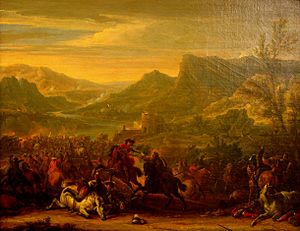Battle of Calcinato facts for kids
The Battle of Calcinato was a big fight that happened on April 19, 1706. It took place near a town called Calcinato in Lombardy, Italy. This battle was part of a larger war called the War of the Spanish Succession.
In this battle, the French army, led by the duc de Vendôme, fought against an army from the Holy Roman Empire, led by Count von Reventlow. The French side won the battle.
Quick facts for kids Battle of Calcinato |
|||||||
|---|---|---|---|---|---|---|---|
| Part of the War of the Spanish Succession | |||||||
 The Battle of Calcinato by Jean-Baptiste Martin. |
|||||||
|
|||||||
| Belligerents | |||||||
| Commanders and leaders | |||||||
| Strength | |||||||
| 23,000 | 10,000-12,000 | ||||||
| Casualties and losses | |||||||
| 500 killed or wounded | 8,000 killed, wounded and captured 6 guns, 16 flags and standards |
||||||
What Led to the Battle?
By 1706, France and its friends controlled most of Northern Italy. They also held areas like Villefranche and the County of Savoy. These places are now part of modern France.
The ruler of Savoy, Victor Amadeus, only had his capital city, Turin, left. An army from the Holy Roman Empire tried to help him. But the French stopped them at the Battle of Cassano in August 1705.
However, the French didn't have enough soldiers to completely surround Turin. This allowed the city to get more troops and supplies. Both armies then stopped fighting for the winter.
In early 1706, Prince Eugene went to Vienna. He wanted to get more soldiers and money for the next part of the war. He left a Danish general, Count von Reventlow, in charge. Count von Reventlow's army was split between Montichiari and Calcinato.
Each of these places was strong on its own. But they were too far apart to help each other quickly. The 12,000 soldiers at Calcinato were mostly German. They were about 11 kilometers away from their friends at Montichiari.
The French army spent the winter near Castiglione and Mantua. In April, a French general named La Feuillade took 40,000 men to surround Turin.
Vendôme, the French commander, pretended to be sick and low on supplies. He wanted the other side to think he wasn't ready to move. But on April 18, he secretly took 18,000 foot soldiers and 5,000 cavalry (soldiers on horseback). They marched all night towards Calcinato. They reached the Lonato Canal at dawn on April 19.
The Battle Begins
The French army surprised the Imperial forces quite a bit. But the French had to cross a canal and then go uphill to attack. This delay gave Count von Reventlow time to get his defenses ready. He was at a disadvantage because most of his army's cannons were at Gavardo.
Vendôme used his own cannons to cover his attack. The French soldiers on the right side charged the Imperial left side. They used their bayonets (knives on the end of rifles) and pushed the Imperial soldiers back.
Count von Reventlow and his cavalry tried to get their soldiers to fight back. But then the Imperial army's right side also started to give way. Because of the large gap between his soldiers and those at Montichiari, von Reventlow was in danger of being cut off from Salò.
He gave the order to retreat. But, as often happens in battles, what started as an organized retreat quickly turned into a confused run. The Imperial army lost more than 3,000 soldiers who were killed or hurt. They also lost most of their supplies and up to 3,000 soldiers were captured.
What Happened After?
After the battle, Vendôme captured Gavardo and Salo. He pushed the Imperial forces back into the Trentino valley. However, Prince Eugene returned in time to gather his scattered troops. He then led them around Lake Garda and into the Province of Verona.
After this, the war in Italy started to go badly for the French. They lost another big battle at Ramillies in May. Because of this, Vendôme and many French soldiers had to move to Northern France.
At the same time, the Imperial army in Italy got a lot more soldiers. Other powerful countries paid for another 20,000 German soldiers to join them. They also renewed their agreement with Prussia, getting more help.
See also
 In Spanish: Batalla de Calcinato para niños
In Spanish: Batalla de Calcinato para niños

